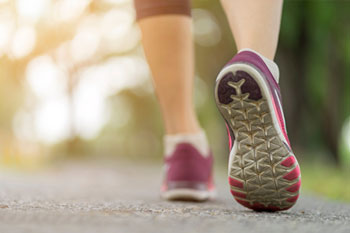
A person’s gait is their pattern of walking or running. An ideal walking gait is a cycle of movement with proper alignment and coordination throughout these 8 specific phases:
- Initial Contact
- Loading Response
- Mid-Stance
- Terminal Stance
- Pre-Swing
- Initial Swing
- Mid-Swing
- Terminal Swing
Common Gait Abnormalities
Everyone should be able to move efficiently: without pain or limited range of motion. Normal patterns of walking can also help avoid gait abnormalities such as:
Overpronation - where the foot rolls inwardly too much
Scissor Gait - where bends in the legs mimic scissor movement when walking (common in cerebral palsy)
Toe Walking - walking on the toes without putting weight on the heels
Foot Drop - not being able to, or having an impaired ability to raise the foot from the ankle or raise the toes
Biomechanics and Gait Analysis
Biomechanics is the study of motion, function, and structure of mechanical aspects of the body. When there is pain in the feet or ankles or problems with mobility, a podiatrist will perform a gait analysis to diagnose and treat the issue.
A gait analysis can help determine the following:
- The source of pain when walking or standing
- Muscle or nerve dysfunction
- How certain diseases are progressing, such as muscular dystrophy or arthritis
- Skeletal misalignments or bone deformities
- The source of nerve, skeletal or muscle problems
How is a Gait Analysis Performed?
A gait analysis will begin with the patient on a treadmill, walking or running. The session will be videotaped. Markers or electrodes on the skin and sensors may be used to aid in the review of the video later. A podiatrist will watch the patient’s gait in real time with particular emphasis on their feet, ankles, knees and hips.
The recorded video will display on a laptop. The podiatrist can freeze frames or play the video in slow motion, with the aid of the markers, to assess in detail how the patient’s feet and ankles move throughout the gait cycle. These details may include the patient’s stride and step length, how long the gait cycle lasts, and joint angles.
Athletic Injuries and Biomechanics
Poor biomechanics are often the cause of overuse injuries that runners and other athletes often suffer from. Many athletes benefit from a gait analysis which can help a podiatrist identify and correct issues to improve alignment, distribute weight evenly and increase efficiency. This can all help prevent overuse injuries such as:
- Plantar Fasciitis
- Shin Splints
- Jumpers Knee
- Runners Knee
- Lower Back Pain
- Achilles Tendonitis
To protect yourself from injury, reduce pain, and improve your mobility, schedule an appointment with your podiatrist for a gait analysis today.

